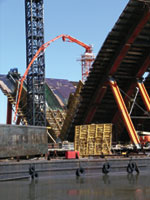 |
If you are feeling nostalgic for the 1970s, forget about dusting off the lava lamp. Go to a construction bid closing these days where estimators are having flashbacks to 70s-style materials price inflation. An explosion in scrap steel prices during the first quarter got the ball rolling with huge price increases for almost every construction product made of steel. But steel now has more company, as other key materials face price gyrations.
Commodity markets are in turmoil, resulting in price increases from 15 to 45% for copper, stainless steel and aluminum construction products. Record crude oil prices in the second quarter also are starting to feed through to higher prices for asphalt paving, PVC pipe and roofing materials, not to mention rising gasoline and diesel fuel costs.
The primary user of many construction materials, the home building sector, ignored predictions that it would start to cool in 2004, and is instead roaring ahead.
Materials suppliers who had reduced inventory levels in anticipation of lower demand were caught short, adding more fuel to inflation, says Amy Carneal, construction materials analyst for Global Insights Inc., Washington, D.C. The result is annual price inflation of 48% for plywood and 28% for lumber, according to ENRs 20-city average price. Gypsum wallboard prices also are moving and are now 9% above a year ago, ENR data show.
Concrete products, long the poster child for price moderation, are curiously experiencing the largest price hikes in more than a decade. In the past, ready-mix concrete producers typically asked for a $2-to-$3-per-cu-yd increase, but the market would beat that back to about 50¢, says Jim Butler, an estimator for Cleveland Cement Co., Cleveland, Ohio. "This year, we have already had a $4-to- $5-per-cu-yd increase stick, and producers say they will be asking for another $3 to $4 hike later this year," he says. Producers cite shortages but there are no delivery problems normally associated with shortages, he notes.
However, availability is a concern in some areas. "We have seen a 35% increase in ductile iron pipe and a 20% increase for PVC pipe prices this year," says Brad Johnson, owner of Westech, a Portland, Ore.-based utility contractor. But getting the product, especially large-diameter pipe, can be just as costly. He notes a recent project that was delayed six weeks waiting for pipe delivery.
The surge in steel and other commodity prices came on the front cusp of an increase in demand and appears to have shattered the psychological barrier against price hikes. "We are seeing the front end of something that I expect to continue," says Julian Anderson, Phoenix-based partner for project cost consultant Rider Hunt Levett & Bailey. "The rise in steel prices has taken the leash off, and I detect more willingness in the marketplace to pump up margins. People are seeing how far they can push it."
Unlike the "noninflationary" expansion of the 1990s, todays economic recovery has taken a different turn. This time around, the rest of the world is also expanding. "What is driving commodity prices, and inflation in general, is building cost pressure on a global scale," says John Mothersole, a Global Insights economist. "Layered on...

Post a comment to this article
Report Abusive Comment